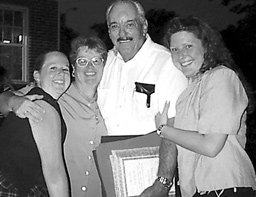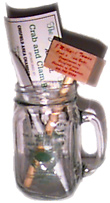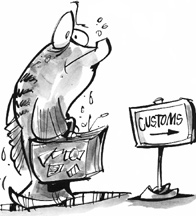|
|
 |
photos courtesy of Maryland Department of Business and Economic Development
Twenty submariners traveled from Georgia to Anne Arundel County for some warm Maryland hospitality. The Gold Crew of the USS Maryland scraped and sweated and bagged oyster shells for planting, providing free labor for four local community groups. |
Submariners Land in Chespeake Country to Sweat and Scrape for Local Community GroupsTradition plus Maryland’s warm hospitality drew 20 submariners all the way up from Georgia last week to sweat, scrape and bag oyster shells.
“This is totally different from our Navy life,” said Executive Officer John Zimmerman from the USS Maryland.
Zimmerman was talking about the visit of the submarine’s Gold Crew to Maryland last week to volunteer on community service projects. The USS Maryland, a nuclear submarine based out of King’s Bay, Georgia, is named after our state. It’s a Navy tradition, according to Zimmerman, that submariners come to their namesake state to work for communities three to four times a year for a week at a time.
The Maryland’s two crews, Blue and Gold, alternate being on land and at sea in 110-day cycles. One crew stays at sea for about 70 days, then returns for the other crew to do 30 days maintenance on the ship before heading out for their 70 days at sea. While on land, the crew trains at base. The rotation allows the ship to be at sea most all of the time, Gold Crew Commander Rusty Smith said.
 Last week, some 20 members of the Gold Crew volunteered to drive 700 miles to Maryland while the Blue Crew was out to sea. Their destination was Anne Arundel County, where they chipped in with some free labor for four community groups: Gateway at Admiral Oaks, the Chesapeake Children’s Museum, the Annapolis Family Support Center and the Chesapeake Bay Foundation. While working, they also made friends and enjoyed what Commander Smith called “warm Maryland hospitality.”
Last week, some 20 members of the Gold Crew volunteered to drive 700 miles to Maryland while the Blue Crew was out to sea. Their destination was Anne Arundel County, where they chipped in with some free labor for four community groups: Gateway at Admiral Oaks, the Chesapeake Children’s Museum, the Annapolis Family Support Center and the Chesapeake Bay Foundation. While working, they also made friends and enjoyed what Commander Smith called “warm Maryland hospitality.”
At Chesapeake Children’s Museum, the submariners constructed and painted seats for a toadstool amphitheater, an outdoor classroom space for storytelling and nature talks. In addition to making nice, small, toadstool-shaped seats, the submariners took on a big job. They painted the sides and the back of the building, which needed help in making the transition from old radio station WYRE into Chesapeake Children’s Museum.
Their work brought the museum a step closer to opening. After years of temporary locations, the museum finally leased this building for its home. Along Spa Creek, it’s surrounded by five and a quarter acres of city-owned parkland. But there’s still work to be done, installing the mandatory $25,000 sprinkler system and building exhibits, as well as raising same to pay for it all.
“We are so grateful,” said Museum Director Debbie Wood, “They were such nice young men.”
Another start-up project brought the Gold Crew to Southern Anne Arundel County. At Discovery Village — a long-closed Johns Hopkins environmental research station — they scrubbed and scraped and ran plumbing for oysters to help get ready for oyster restoration projects. Discovery Village is leased and being renovated by the Chesapeake Bay Foundation, said Foundation’s Fisheries Scientist Stew Harris. After all of the submariners’ help, all that’s needed is final electrical work before they’re ready to open.
The sailors got the Foundation “over the hump for getting the facility up and running,” Harris said.
“They are a great bunch of guys and they did a fantastic job, saving us a lot of time and effort.”
Wood wished the departing volunteers “fair winds and following seas.” Maryland had been up the Bay to Annapolis before, but nowadays, with more serious business to attend to, their journeys are secret.
“It’s hard to think they’re out their defending our country. I wish they were just out there fishing,” she said.
— Katie McLaughlin
 |
photo by Sandra Martin
Captain Harry Tayloe with family Melissa Blake, Gladys Wilson and Laura Williams |
Reluctant Heroes Fish Our Waters
“All too often, we overlook heroism in our midst,” said Chesapeake Beach Town Council President Bruce Wahl.
Chesapeake Beach Town Chambers are not much bigger than a playhouse. Even after dark on a steamy July Thursday, the air conditioning was no match for the body heat of the overflow crowd crushed inside. Among all that citizenry, three men compressed their necks into their shoulders turtle style, hoping fervently to be overlooked.
But no, Wahl commanded the heroes forward, and up they came, bashfully, envying the pair from their number who’d stayed away. Together on the dais, charter captains Harry Tayloe and Greg Buckmaster and crewman Bobby Buckmaster endured the adulation, the fine words, the applause, the camera flashes.
“Me and Greggy didn’t want to be faced with it either,” barked Tayloe, when, amid the litany of praise, Del. George Owings said “Nobody gets up in the morning and goes to work thinking to be a hero on water or at work.”
But fate had put them where the work of heroes needed to be done, and they had acquiesced, saving six lives.
On May 28, fate ordered Captain Greg Buckmaster and his crew on the crabboat Three Gs V — Bobby Buckmaster and Donnie Eastridge — away from their crab pots. Over his on-board radio, Buckmaster had learned of a capsized boat. Despite worsening weather and his better judgment, Buckmaster and his men searched the rolling waves, at last pulling three men from the danger of the churned-up Bay and into the sanctuary of their boat. A rescue squad with ambulances met the Three Gs at Breezy Point — but not before Buckmaster had given the shirt off his back — his favorite hunting shirt, no less — to one of the shipwrecked fishermen, whose name he never learned.
Now, they were paying for their good deed, with plaques and praises pressed upon them. And not only from the town of Chesapeake Beach. No, the Calvert County Commissioners had to add their congratulations. On top of that came the praise of the Maryland Senate and House of Delegates.
“Heroes come in all sizes, shapes and actions,” said Commissioner Barbara Stinnett, presenting a citation signed by all five members of Calvert County’s Board of Commissioners.
“People right here made history saving lives, and I’m proud of them,” Stinnett added, pressing on them, by way of her day-job boss, Sen. Roy Dyson, a certificate of senatorial recognition.
As Del. Owings added his House’s share, the three heroes squirmed.
“Your action or inaction meant the difference between someone living or dying,” he said, extending all 141 delegates’ “deepest congratulation in recognition of the unselfish acts of you and fellow watermen.”
Ears burning and hands full of resolutions, Tayloe could only shake his head.
“I could not get over the hullabaloo,” he said after escaping into night air that, by comparison, felt as cool as the waters of the Chesapeake Beach Waterpark next door.
“I’m 70 and kinda retired. It’s the fourth time in over 35 years I pulled people out of the water. But this is the first time it became a big event, with tv coverage and personalities all over. It was all because two died. If they had not died, it wouldn’t have been a big deal.
“Makes you think doesn’t it?” he mused.
Heroism came to Harry Tayloe in the early afternoon of June 2. That rough, windy Sunday, he took out a late fishing party for old time’s sake, borrowing both his grandson, John Murphy, and Murphy’s charter boat Wendy Sea.
“It was blowing up rough,” he recounted. “At the channel, I looked at the water and I could see flotsam: life preservers and coolers.”
From on the bow, Murphy saw people in the water.
“It was hard to do in the rough water, but we maneuvered and took a man and two girls aboard, Tayloe recounted.
“The man was in bad shape, shock. The girls were hysterical, screaming there were two other people with them. They’d seen them sink, a seven-year old girl and a 21-year-old man.
“I just wish to God, I could have been there five or 10 minutes sooner,” Captain Tayloe said, feeling the weight of heroism.
— SOM
 Annual Tawes Crab Feast Crawling with Pols Annual Tawes Crab Feast Crawling with Pols
For Marylanders, a pile of steaming hot hard shell crabs and a pitcher of beer defines summer. For Maryland politicians in Primary Season, they’ll take their crabs along with all the hands they can shake. Just don’t expect them to sit down long enough to pick a crab.
At the 26th annual J. Millard Tawes Crab and Clam Bake in Crisfield, the premier summer event for both politicians and seafood lovers, there was much to feast on. Crabs, steamed clams, corn on the cob, fish sandwiches, watermelon and bottomless mugs of beer. While patrons stood in lines for steamed crabs, their hands and pockets filled up with bumper stickers, pamphlets and posters.
With state elections only once every four years, a new crop of hopefuls joined with household names and perennial wannabes in working the crowds and pressing the flesh. The most familiar name appeared on the bright yellow stickers touting William Donald Schaefer.
But the political feeding frenzy surrounded gubernatorial candidates Kathleen Townsend Kennedy and Robert L. Ehrlich — flanked by running mates Chuck Larson and Michael S. Steele — arriving to the raucous beat of their own bandwagons. Throngs of faithful followed, cheering, as cameras rolled.
Then, as quickly as they came, the big names departed, leaving this crowd to smaller fry and volunteers, who handed out more stickers and pamphlets and refilled their souvenir mugs with frosty beer.
On a hot, July day, some 300 bushels of locally caught Maryland blue crabs was just about the right combination for a hungry crowd of about 5,000 at a fest seasoned with politics.
— M.L. Faunce
EEEK! Gather the Kids: The GIANT Snakehead May Be on the Way …
Interior Secretary Gale Norton hasn’t had many opportunities to be portrayed as a protector of the environment — until that aquatic villain of Anne Arundel County arrived to menace us all.
 This week, amid frenzied media coverage of the northern snakehead in Crofton, the Bush administration cabinet member that conservationists trust the least announced at a news conference her plan to ban snakehead import into the United States for food or aquariums. This week, amid frenzied media coverage of the northern snakehead in Crofton, the Bush administration cabinet member that conservationists trust the least announced at a news conference her plan to ban snakehead import into the United States for food or aquariums.
“These fish are like something from a bad horror movie,” Norton said, describing their ability to travel out of water.
“They can eat virtually any small animal in their path. They can travel across land and live out of water for at least three days. They reproduce quickly. They have the potential to cause enormous damage to our valuable recreational and commercial fisheries,” she added.
Interior Department officials said that in addition to Maryland, snakeheads have been found in open waters in six other states: California, Florida, Hawaii, Maine, Massachusetts and Rhode Island.
Among the 28 species of snakeheads, one official noted, is the giant snakehead, which has been known to attack humans if spooked or threatened.
Fish and Wildlife Service director Steve Williams warned that the fight against the snakeheads could be challenging, if not unwinable.
“Regrettably, the information we have collected — including our recent information from Maryland — indicates that snakeheads are very likely to escape or be released into the wild and possibly become established,” he said.
“They will feed on native fish, amphibians, crustaceans, small reptiles and small mammals. They are likely to compete with our native species for food. They may spread parasites or pathogens into native species. They will be extremely difficult to eradicate,” he added.
Wildlife officials said that nearly 17,000 snakeheads are known to have been imported into the United States from Asian countries between 1997 and 2000 alone. They have been widely available in live food fish markets, northeastern restaurants and even via the Internet.
The snakehead trade soon will be more difficult: The Interior Department intends to ban the imports, adding them to a list of “injurious wildlife” that can’t be brought into this country by federal law.
The Interior Department will formally propose its ban in the Federal Register in a few days. People wanting to comment can do so with an e-mail to [email protected].
Way Downstream …
On the Eastern Shore, folks are worried that the Chesapeake Bay Maritime Museum’s proposed Recreation on the Bay building at Navy Point will disrupt recreation on the Bay. Locals and regular visitors complained at a standing-room-only hearing last week that the building would take away waterfront viewing and walking, the Star Democrat reported …
On the Chesapeake Bay, you can follow jellyfish via boat or Internet. At http://orbitnet.nesdis.noaa.gov/orad2/doc/seanettlemain.html, see weekly scientific updates of where the stinging devils are believed to be lurking …
In New York, utilities are deploying pizza power in a program urging people to conserve. On a quarter-million pizza boxes destined for delivery, the Long Island Power Authority is printing “Watts Going Down” and other phrases …
In Southern California, environmentalists are challenging a new Navy plan that blasts sonar across swaths of the ocean to detect submarines protected by stealth technology. The Natural Resources Defense Council said it might sue after the National Marine Fisheries Department last week gave the Navy the permit it needs …
Our Creature Feature comes from Yellowstone National Park, where a Minnesotan recently endured a double indignity: After being gored by a bison, the fellow faces charges of harassing wildlife.
Paul Jocelyn, 37, received a puncture wound in his thigh and other injuries after trying to prompt a one-ton bull bison to raise its head for a photograph near Old Faithful Geyser. The bison apparently was camera shy. It chased the man and then flung him skyward like a rag doll. Authorities had no mercy, either, saying that people are required to keep 25 yards away from bison, who have nasty tempers and run 30 mph.
Copyright 2002
Bay Weekly
|